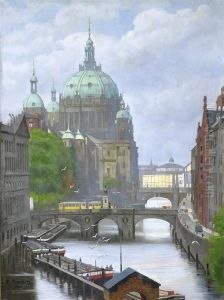Bersch Fritz Paintings
Fritz Bersch was an Austrian painter known for his landscape paintings, genre scenes, and portraits. He was born on February 18, 1873, in Vienna, Austria. His artistic talents were evident from a young age, and he pursued his passion for art by studying at the Academy of Fine Arts Vienna. There, he was taught by several prominent artists of the time, including Christian Griepenkerl and Sigmund l’Allemand.
During his career, Bersch was associated with a style known as Impressionism, although his work also shows elements of Realism. His landscapes often reflect the beauty of the Austrian countryside and are characterized by a vibrant palette and dynamic brushwork. This style was inspired by the broader European Impressionist movement, which emphasized light and color over precise detail. However, Bersch’s work is often noted for its unique blend of this style with the more traditional techniques that were prominent in Austrian art at the time.
Bersch's portraits and genre scenes, on the other hand, showcase a more detailed approach, with a focus on the character and mood of the subjects. His ability to capture the essence of his sitters made him a sought-after portraitist during his lifetime.
Despite his contributions to Austrian art, Fritz Bersch remains a lesser-known figure in the art historical canon, often overshadowed by his contemporaries. However, his work provides an interesting insight into the art scene of Austria at the turn of the 20th century, as it was transitioning from traditional styles to more modern approaches.
Fritz Bersch’s career was also inevitably impacted by the two World Wars that marked his lifetime. The political and social upheaval throughout Europe during this period affected the production and reception of art, as well as the lives of artists themselves. Bersch continued to work during these tumultuous times until his death on April 6, 1945, in Vienna, just a month before the end of World War II in Europe. His works are part of various collections and continue to be appreciated by those interested in Austrian art history.
